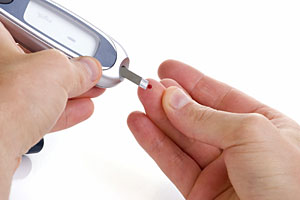 |
Diabetes Mellitus which manifests as increased blood sugar in the patients is so rampant in Nepal that even nuances in the treatment have become important. Some years ago a robust trial (United Kingdom Prospective Diabetes Study, UKPDS) in over 5,000 diabetic patients revealed that with 'tight' blood glucose control, eye problems, kidney problems and nerve problems were significantly decreased. The study population was Type 2 diabetics just like the vast majority of diabetics seen in Nepal, who are affected by the disease (not early but later in their lives).
As we are increasingly starting to find out in Nepal, uncontrolled diabetes more commonly requires dialysis due to kidney failure, eye surgery for retinal hemorrhages, and even amputations for nerve and vasculature related problems. In other words, conscientiously controlling blood sugar leads to fewer complications of the kidneys, eyes and nerves. In medical parlance these are called "microvascular" complications. Unfortunately in medicine what may seem to be an obvious cause (high blood sugar) and effect (complications) does not always pan out.
Indeed, as revealed in the same UKPDS trial what the tighter control of blood sugar did not do was decrease macrovascular complications in other important organs that diabetes has a serious impact on, namely the heart and the brain. So, despite a good control of blood sugar, the rates of heart attacks and strokes in these patients did not improve, although there was a decrease in kidney and eye problems. However, there was a silver lining in the study.
Hypertension or high blood pressure usually goes hand in hand with diabetes. Hypertension is an important risk factor for both heart attacks and strokes. So, those diabetics in the study who had proper control of blood pressure clearly had fewer strokes and heart attacks independent of their blood glucose control.
The "take home message" for diabetics is that it is important to keep both the blood pressure and blood glucose under proper control so that the important organs (including the heart, brain, eyes, kidneys) that diabetes affects are protected.
Furthermore, unlike high blood sugar in a patient which usually manifests with excessive urination, thirst, and hunger, high blood pressure may essentially have no symptoms to start with until there is that catastrophic stroke or heart attack. The prevention of both diabetes and hypertension with "way of life" changes also needs to be emphasised.


